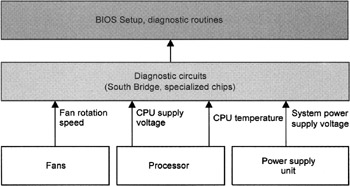Chapter 6: Computer Hardware Monitoring
Chapter 6: Computer Hardware Monitoring
Overview
The complex hardware and advanced functionality of modern computers require the operation of the main computer subsystems to be monitored and controlled. This can be achieved using built-in tools known as hardware-monitoring tools. These tools have become a de facto standard of the architecture implemented in most contemporary motherboards. They are supported both by BIOS Setup and by special-purpose software, including such popular programs as Motherboard Monitor (MBM).
Designers and manufacturers of contemporary hardware, under the extremely competitive conditions of the market, always try to implement the highest potential performance of hardware components. Aiming for this goal, they provide various functions for implementing overclocked modes.
This trend for computer-hardware optimization, along with the overclocked modes that can provide maximum performance, often requires strict control over the main operating parameters. This ensures the selection of an efficient operating mode, as well as a level of protection. Therefore, motherboard manufacturers often provide built-in hardware-monitoring tools, ensuring support for diagnostics and control over the most important operating parameters of the main computer subsystems and components.
In general, the list of such parameters includes the following:
-
Temperature of the CPU, motherboard, air within the case, etc.
-
Core voltage of the CPU, motherboard components, etc.
-
Rotation speed of the coolers installed on the processor, power supply unit, etc.

Figure 6.1: Diagram of computer hardware monitoring






